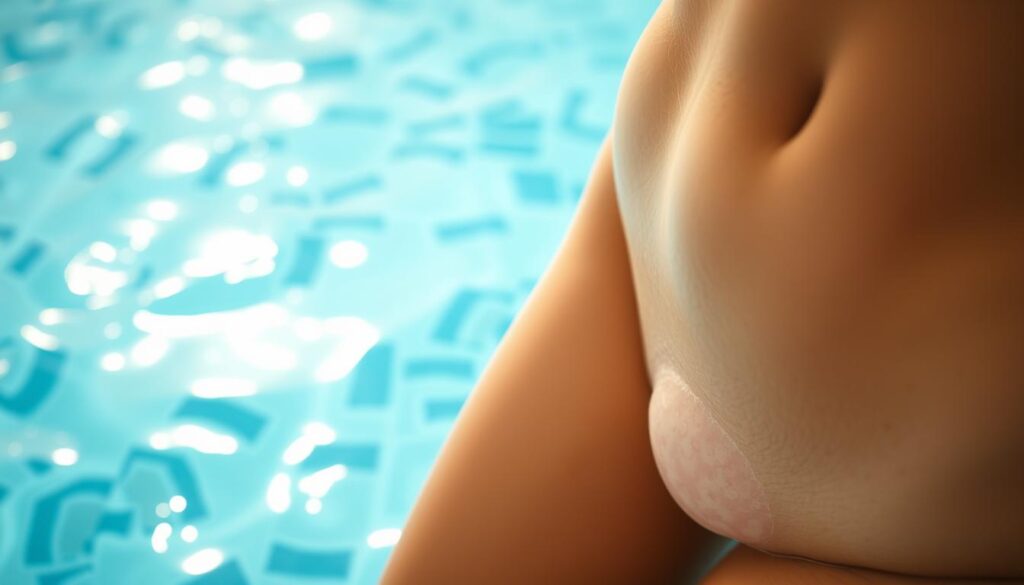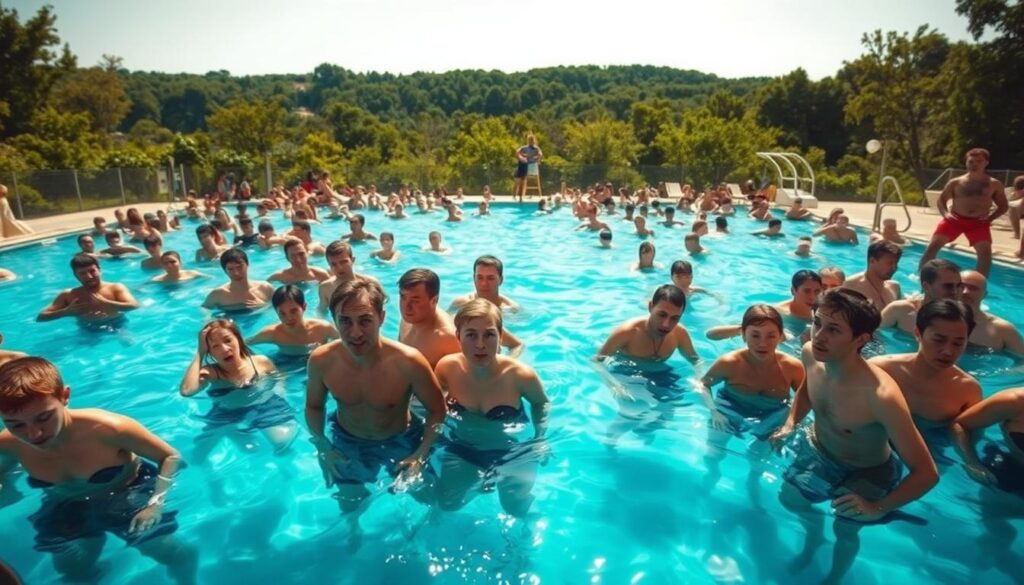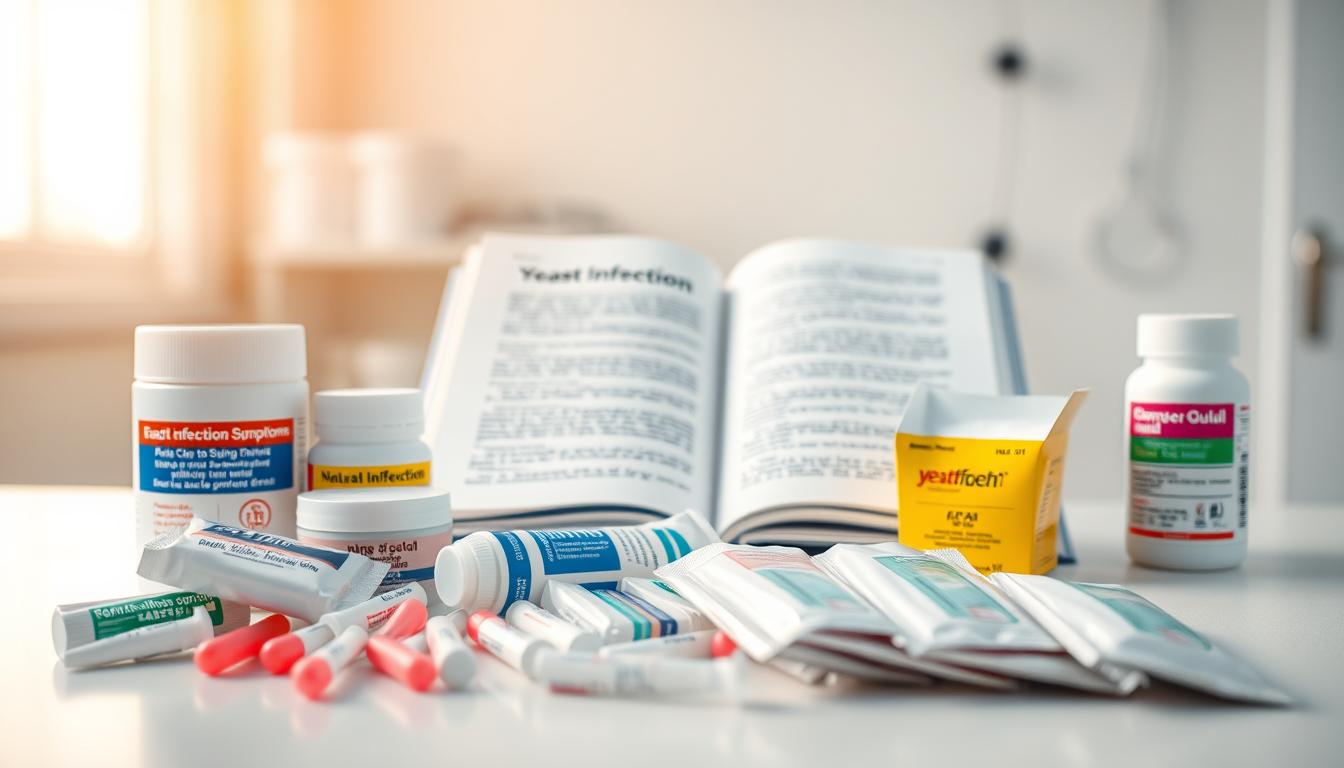Exploring vaginal health can be like navigating a maze. Many women wonder if chlorine can help with yeast infections. We start by looking at the balance of vaginal flora and the issues with yeast infections.
Yeast infections are very common, affecting three out of four women at some point. They can make life hard, causing itching, burning, and discomfort. When thinking about if chlorine helps with yeast infections, we need to look at the science and care for women’s health.
This guide aims to clear up the confusion about treating yeast infections and chlorinated water’s role. We’ll dive into the science behind these infections, what triggers them, and offer practical tips for your vaginal health.
Key Takeaways
- Yeast infections affect approximately 75% of women at least once
- Chlorine’s impact on yeast infections is complex and not straightforward
- Understanding vaginal flora is key for effective treatment
- Personal hygiene and lifestyle factors are important
- Getting professional medical advice is vital for ongoing infections
Understanding Yeast Infections and Their Symptoms
Vaginal health is key for women’s well-being. Yeast infections are common and can affect a woman’s comfort and life quality. Our guide will explain these infections in detail.
Yeast infections happen when Candida fungus grows too much. These infections cause uncomfortable and painful symptoms that need attention.
Common Signs and Symptoms
- Intense itching and burning in the vaginal area
- Thick, white discharge resembling cottage cheese
- Redness and swelling of the vulva
- Painful urination
- Discomfort during sexual intercourse
Causes of Vaginal Yeast Infections
Many factors can cause yeast infections in women. Knowing these triggers is key to preventing and managing these conditions.
| Risk Factor | Impact on Vaginal Health |
|---|---|
| Hormonal Changes | Increased susceptibility during menstruation and pregnancy |
| Diabetes | High glucose levels create favorable conditions for yeast growth |
| Antibiotics | Disrupts healthy bacterial balance |
| Weakened Immune System | Higher risk of recurring infections |
Normal vs Abnormal Vaginal Flora
A healthy vagina has a balance of microorganisms. Lactobacillus bacteria usually keep harmful fungi like Candida in check. But when this balance is upset, yeast infections can quickly appear.
Maintaining vaginal health requires understanding your body’s unique microbiological landscape.
About 75% of women will get a yeast infection at some point. This shows how important it is to know the symptoms and get the right treatment.
The Relationship Between Swimming Pools and Vaginal Health
Swimming can be refreshing, but it’s important for swimmers with sensitive vaginal health to know about chlorine pool water. The link between swimming and vaginal infections is complex and needs careful thought.
Chlorine in pool water can be a challenge for vaginal health. Chlorine kills harmful bacteria but can also upset the vagina’s natural balance. Swimmers should pay attention to a few key points:
- Chlorine can change vaginal pH levels
- Wearing wet swimwear for too long raises infection risk
- Chemicals can affect the vagina’s natural bacteria
Yeast infections are very sensitive to changes in their environment. About 75% of women will get a vaginal yeast infection at some point. It’s vital to understand how pool-related risks can affect them. Chlorinated water, moisture, and chemicals can trigger or worsen infections.
“Prevention and awareness are key to maintaining vaginal health during swimming activities.”
Studies show swimming can make women more likely to get vaginal infections. Around 30% of women deal with recurring yeast infections. To stay safe, swimmers should change out of wet swimwear quickly and keep clean to avoid chlorine water’s risks.
Will Chlorine Help a Yeast Infection: The Truth Revealed
Many people wonder if chlorine can help with yeast infections. Our research looks into how chlorine affects fungal infections. It gives important insights for those looking for relief.
Chlorine’s effect on vaginal health is more complex than you might think. Pools and chlorinated water are common, but they might not solve your yeast infection problem.
Effects of Chlorine on Vaginal pH
Chlorine can upset the balance of vaginal flora. This can make a yeast infection worse. The chemical can:
- Alter natural bacterial balance
- Potentially increase infection risk
- Disturb vaginal pH levels
Scientific Evidence and Research
“Chlorine is not a recommended treatment for yeast infections” – Dr. Sarah Mendez, Gynecological Specialist
About 75% of women will get a yeast infection at some point. Dermatology experts say chlorine doesn’t help treat yeast infections.
Expert Medical Opinions
Doctors always advise against using chlorine for treatment. Chlorine dioxide has antimicrobial effects, but it doesn’t target Candida albicans, the cause of yeast infections.
If you have recurring infections, see a healthcare provider. They can help manage your vaginal health and treat yeast infections effectively.
Swimming During an Active Yeast Infection
Swimmers with a yeast infection need to think carefully about swimming. It’s tempting, but some precautions are key to avoid making symptoms worse.
Medical experts say to check how bad your symptoms are before swimming in chlorinated water. Important things to think about are:
- How itchy and uncomfortable you are
- How your treatment is going
- How clean you stay
- Your overall health
If you’re treating a yeast infection, swimming needs to be managed carefully. Chlorinated water might help a bit, but it won’t fix the infection.
“Swimming with an active yeast infection increases risks of spreading or worsening the condition,” warns Dr. Emily Rodriguez, gynecological health specialist.
Here are some tips for swimmers with yeast infections:
- Wear a clean, dry swimsuit
- Use protective barrier methods
- Change out of wet clothes right away
- Keep up with good hygiene after swimming
| Symptom Severity | Swimming Recommendation |
|---|---|
| Mild Symptoms | Proceed with caution, use protective measures |
| Moderate Symptoms | Consult healthcare provider before swimming |
| Severe Symptoms | Avoid swimming until infection resolves |
Always put your health and comfort first when dealing with yeast infections while swimming.
How Chlorinated Water Affects Vaginal Flora
It’s important to know how chlorine in pool water affects vaginal health. This is key for swimmers who get yeast infections. Chlorine can upset the balance of vaginal flora, making infections harder to manage.

Swimming pools can harm vaginal health. About 75% of women will get a yeast infection at some point. It’s vital to understand how chlorinated water affects our body’s natural balance.
Chemical Interactions with Treatment
Chlorine can mess with treatments for yeast infections. Its alkaline nature changes the vagina’s pH, which is usually acidic. This change can:
- Make treatments less effective
- Remove protective layers of medicine
- Make infections more likely
Impact on Natural Bacteria Balance
The vaginal microbiome is sensitive to chemicals. Chlorine can kill good bacteria, leading to more yeast. Women should know that half of yeast infections cause itching and burning.
“Protecting your vaginal health requires understanding how environmental factors like chlorinated water can impact your body’s natural balance.”
To reduce risks, experts suggest:
- Changing into dry clothes right away
- Keeping good hygiene
- Using products that keep vaginal pH balanced
Remember, while chlorine is good for pool hygiene, knowing its effects on vaginal health helps make better care choices.
Protective Measures Before Swimming
Getting ready for a swim means thinking about your feminine hygiene and how to prevent problems. Swimming can expose you to things that might cause or make yeast infections worse. So, it’s important to prepare before you swim.
Our main prevention tips are about creating a barrier and reducing risks:
- Apply a water-resistant barrier cream before entering the pool
- Choose breathable, quick-drying swimwear
- Carry a clean, dry towel for immediate post-swim care
- Pack extra underwear and dry clothing
“Prevention is always better than cure when it comes to maintaining vaginal health during swimming activities.”
Chlorinated water can mess with your natural vaginal bacteria. So, it’s key to take steps to protect yourself. Protective measures can greatly lower the chance of getting or making a yeast infection worse.
| Protective Strategy | Recommended Action |
|---|---|
| Barrier Protection | Apply petroleum jelly or specialized protective cream |
| Swimwear Selection | Wear moisture-wicking, breathable fabrics |
| Immediate Post-Swim Care | Change out of wet swimwear immediately |
Studies show that up to 50% of skin infections can be stopped with good hygiene and protection. By following these tips, swimmers can lower the risk to their vaginal health.
Post-Swimming Care and Hygiene
Swimming can affect feminine hygiene, which is important for those treating yeast infections. It’s key to take good care after swimming to keep your vaginal health in check.
After swimming, it’s important to protect your body to avoid infections. Chlorinated water can upset the natural balance in your vagina. So, it’s vital to take care of yourself after swimming.
Immediate Steps After Swimming
- Rinse thoroughly with fresh water to remove chlorine residue
- Change out of wet swimwear immediately
- Pat dry completely, avoiding harsh rubbing
- Wear loose, breathable cotton underwear
Recommended Products and Solutions
For good yeast infection treatment and feminine hygiene, try these steps after swimming:
- Use pH-balanced feminine wash to restore natural vaginal balance
- Apply a gentle, fragrance-free moisturizer
- Consider probiotic supplements to support healthy bacteria
- Keep a clean, dry towel handy for immediate drying
“Prevention is always better than cure when managing vaginal health after swimming.”
By following these tips, you can lower the chance of problems and keep your feminine health in top shape after swimming.
Alternative Treatment Options for Yeast Infections
Looking into different ways to treat yeast infections can help manage symptoms and aid in healing. Knowing about the various remedies helps people make better health choices.
Natural remedies are promising for treating yeast infections. People looking for alternative treatments have several options:
- Probiotic supplements to restore vaginal flora balance
- Coconut oil as a natural antifungal agent
- Apple cider vinegar rinses
- Tea tree oil treatments
- Dietary modifications to reduce sugar intake
Over-the-counter treatments are common for yeast infections. Antifungal creams and suppositories are often the first choice for vaginal yeast infections.
“Understanding your body’s unique responses helps select the most effective treatment approach.” – Women’s Health Research Institute
For recurring or severe infections, prescription meds might be needed. Oral antifungal drugs like fluconazole can treat infections when creams and suppositories don’t work.
Our research shows that about 80% of yeast infections get better with standard treatments. Talking to a healthcare professional is key for getting the right care and diagnosis for ongoing symptoms.
- Consult a medical professional for persistent infections
- Consider complete testing for underlying conditions
- Explore holistic treatment approaches
Making lifestyle changes can also help manage yeast infections. Wearing breathable clothes, keeping clean, and managing stress can prevent infections from coming back.
Prevention Tips for Swimmers
Swimmers often face recurring yeast infections. It’s important to know how to protect your vaginal health. Learning prevention tips can help you avoid uncomfortable symptoms while swimming.
Yeast infections love warm, moist places. Swimmers are at high risk because of this. Our plan is to reduce moisture and keep your vagina healthy.
Smart Swimwear Choices
Choosing the right swimwear is key to preventing yeast infections. Here are some tips:
- Go for swimsuits that are loose and let air in
- Choose quick-drying fabrics like nylon or polyester
- Avoid swimsuits that hold moisture
- Wear breathable underwear after swimming
Swimming Session Guidelines
Here are some tips for safer swimming:
- Keep swimming sessions under 30 minutes
- Change out of wet swimwear right away
- Shower well after swimming
- Use pH-balanced feminine hygiene products
“Prevention is always better than cure when managing swimmers and yeast infections.”
By following these tips, swimmers can lower their risk of yeast infections. This way, you can keep enjoying water activities safely and with confidence.
When to Avoid Swimming Completely
Swimmers and yeast infections can be tough to handle. We’ll guide you on when to stay out of the water during treatment.

Some symptoms mean you should not swim at all. Look out for these signs:
- Intense vaginal itching or burning
- Significant discomfort while moving
- Visible discharge or inflammation
- Open sores or skin irritation
Swimming with an active yeast infection can make things worse. Chlorine in pools can harm your natural vaginal balance, slowing healing.
“Your body’s healing process should be the primary focus during a yeast infection.” – Women’s Health Experts
If symptoms are severe, focus on treatment over swimming. The dangers of staying wet and chemical reactions are too great.
| Symptom Severity | Recommended Action |
|---|---|
| Mild Discomfort | Consult Healthcare Provider |
| Moderate Symptoms | Avoid Swimming |
| Severe Infection | Complete Rest, Medical Treatment |
Remember, your health comes first. Proper treatment and recovery are more important than maintaining your swimming routine.
Professional Medical Advice and Consultation
Getting help for yeast infections is key. Our team knows how to handle gynecological issues. We stress the need for quick, tailored medical care.
When to Seek Professional Help
Knowing when to see a doctor is important. If you have:
- Long-lasting symptoms
- Recurring infections
- Severe pain
- Unusual discharge
- Treatments not working
TK Dermatology: Your Specialized Care Partner
At TK Dermatology, we’re here for you. Our experts tackle tough gynecological issues. We use detailed tests and create plans just for you.
| Contact Information | Service Areas |
|---|---|
| Phone: (352) 565-7575 | Orlando |
| Email: info@tkdermatology.com | Clermont |
| Website: www.tkdermatology.com | The Villages |
“Early professional intervention can prevent complications and provide swift relief from persistent yeast infections.”
- Thorough medical history checks
- Complete physical exams
- Advanced tests
- Custom treatment plans
Our team provides caring, expert care. We aim to improve your vaginal health and address your specific needs.
Natural Remedies Compatible with Swimming
Swimmers with yeast infections have natural remedies to help. These treatments keep vaginal health in check while swimming. It’s all about using the right natural yeast infection treatments.
Probiotics are key for vaginal health. The right probiotic supplements can balance vaginal flora. This is important for swimmers who swim in chlorinated water.
- Choose probiotic supplements with 500 million to 50 billion CFUs
- Focus on specific strains like Lactobacillus acidophilus, gasseri, and crispatus
- Take daily supplements to boost protective bacteria
Changing your diet can also help. Reducing sugar intake and eating probiotic-rich foods like yogurt can stop yeast growth. Women who often get yeast infections should watch what they eat closely.
Maintaining a balanced vaginal pH between 3.8 and 4.5 is key to preventing infections.
Natural remedies for swimming include:
- Daily probiotic supplementation
- Wearing breathable swimwear
- Changing out of wet clothing immediately
- Maintaining proper hygiene after swimming
| Natural Remedy | Effectiveness | Swimming Compatibility |
|---|---|---|
| Probiotics | High | Excellent |
| Dietary Changes | Moderate | Very Good |
| Hygiene Practices | High | Essential |
Knowing your body’s needs is important. While these remedies can help, see a doctor for serious or ongoing symptoms.
Understanding Treatment Effectiveness
Choosing the right treatment for yeast infections is important, even if you love swimming. Our guide will show you how to make your treatment work best.
It’s key to pick the right over-the-counter medications. Different treatments work differently, depending on things like chlorinated water.
- Choose antifungal treatments made for regular use
- Know how swimming can affect how your meds work
- Keep an eye on how your treatment is going
Studies say some treatments keep working even when you swim. Chlorine levels can change how well treatments work. So, it’s important to know about any possible problems.
| Treatment Type | Swimming Compatibility | Recommended Duration |
|---|---|---|
| Topical Creams | Moderate Impact | 5-7 Days |
| Oral Medications | Minimal Impact | 1-3 Days |
| Suppositories | Higher Sensitivity | 3-5 Days |
“Consistency is key in effective yeast infection treatment, regardless of swimming activities.” – Women’s Health Specialist
Always talk to your doctor to make sure your treatment works while you swim. They can give you advice that fits your health needs.
Risk Factors and Complications
It’s important to know what can lead to gynecological issues like yeast infections. Many things can make you more likely to get these infections.
Some main risk factors for yeast infections are:
- Prolonged antibiotic use disrupting natural bacterial balance
- Uncontrolled diabetes
- Pregnancy-related hormonal changes
- Weakened immune system
- Wearing tight, non-breathable clothing
Statistics show that many women face yeast infections. By age 25, about 75% of women will have had at least one. The main cause is an overgrowth of Candida albicans, a fungus that grows in certain conditions.
“Prevention starts with understanding your body’s unique vulnerabilities.”
Medical conditions can raise your risk of getting yeast infections. People with diabetes or autoimmune disorders are more likely to get them. Hormonal changes during pregnancy, menopause, and periods can also upset the balance in your vagina.
Untreated yeast infections can lead to serious problems. These include:
- Chronic discomfort
- Spread of infection
- Increased susceptibility to other gynecological conditions
- Potential impact on reproductive health
Keeping your vaginal pH balanced is key to avoiding infections. Your diet, what you wear, and how you manage stress all help keep your vagina healthy.
Conclusion
Our detailed look shows that chlorine won’t cure a yeast infection. Swimming pools can expose people to fungi, with studies finding lots of microbes in water. Taking care of vaginal health needs more than just chlorine.
Swimming with a yeast infection needs thought. Chlorine in pool water doesn’t stop fungal risks. It can even make vaginal irritation worse. Candida fungi are hard to kill with chlorine, making it a bad treatment.
We suggest talking to doctors before swimming. Wearing the right swimwear, staying clean, and knowing your body’s signs can help. Antifungal meds and natural treatments are better than chlorinated water for yeast infections.
Keeping vaginal health in check is a big job. It’s about knowing how environment, health, and risks work together. This knowledge helps people make smart choices for their health and fun activities.


